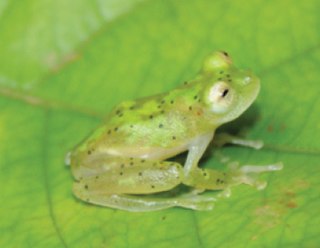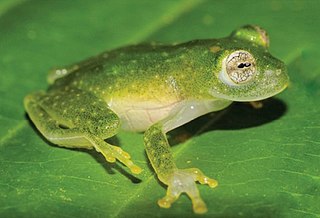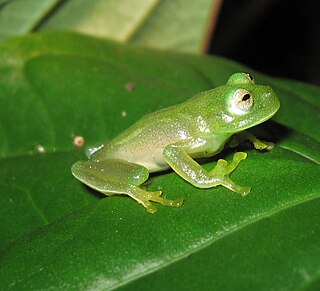
The glass frogs belong to the amphibian family Centrolenidae, native to the Central American Rainforests. The general background coloration of most glass frogs is primarily lime green, the abdominal skin of some members of this family is transparent and translucent, giving the glass frog its common name. The internal viscera, including the heart, liver, and gastrointestinal tract, are visible through the skin. When active their blood makes them visible; when sleeping most of the blood is concealed in the liver, hiding them. Glass frogs are arboreal, living mainly in trees, feeding on small insects and only coming out for mating season. Their transparency conceals them very effectively when sleeping on a green leaf, as they habitually do. However, climate change and habitat fragmentation has been threatening the survival rates of the family.

Hyalinobatrachium is a genus of glass frogs, family Centrolenidae. They are widely distributed in the Americas, from tropical Mexico to southeastern Brazil and Argentina.

Stefania is a genus of frogs in the family Hemiphractidae. They are native to the highlands of the Guiana Shield in southern Venezuela, Guyana, and adjacent far northern Brazil. Most are restricted to the tepui highlands, but S. evansi also occurs in lowlands. On most mountains there are only 1–2 species from this genus, but five are known from Mount Ayanganna and the neighbouring Mount Wokomung has six species. They are usually found near streams at low levels on branches/leaves or on the ground among vegetation/rocks.
Oreophrynella weiassipuensis is a species of toads in the family Bufonidae. It is only known from Wei-Assipu-tepui, a tepui on the border between Brazil and Guyana. The holotype was collected in 2000 by a speleological expedition to Wei-Assipu-tepui. No other specimens are known. It is possible that it is present in other localities, but most species of Oreophrynella are endemic to a single mountain.
Vitreorana castroviejoi is a species of frog in the family Centrolenidae. It is endemic to Cerro el Humo in the Paria Peninsula, Sucre state, northern Venezuela. It is locally known as ranita de cristal de Castroviejo. The specific name castroviejoi honors Javier Castroviejo Bolívar, a Spanish zoologist.
"Cochranella" duidaeana, commonly known as the Duida Cochran frog, is a species of frog in the family Centrolenidae. It is endemic to Cerro Duida, Venezuela. The generic placement of this species within the subfamily Centroleninae is uncertain.
"Cochranella" riveroi is a species of frog in the family Centrolenidae. It is endemic to Cerro Aracamuni, Venezuela. The generic placement of this species within the subfamily Centroleninae is uncertain.
Cochranella vozmedianoi is a species of frog in the family Centrolenidae, endemic to the Cerro El Humo, in the Paria Peninsula in northern Venezuela.
Hyalinobatrachium aureoguttatum, also known as the Atrato Glass Frog and Sun Glassfrog, is a species of frog in the family Centrolenidae. It is found in northern Ecuador, Pacific lowlands and western slopes of the Cordillera Occidental in Colombia, and eastern Panama. It occurs from near sea level to 1,560 m (5,120 ft) asl.
Hyalinobatrachium guairarepanense is a species of frog in the family Centrolenidae. It is endemic to Venezuela, where it is found in locations in the Coastal Range at elevations between 720 and 1,000 m above sea level.
Vitreorana helenae is a species of frog in the family Centrolenidae. Two common names are sometimes used to refer to this species: Venezuelan glass frog and Helena's glass frog. In Spanish, it is locally known as ranita de cristal de Helena.

Hyalinobatrachium iaspidiense is a species of frog in the family Centrolenidae from South America. Its specific name refers Quebrada de Jaspe, its type locality.
Hyalinobatrachium orientale is a species of glass frog in the family Centrolenidae. It is found on the island of Tobago and in eastern Venezuela. Its common name is eastern glass frog. The Tobagonian population has been described as subspecies Hyalinobatrachium orientalis tobagoensis(Hardy, 1984). The latter is sometimes referred to as Tobago glass frog. H. orientale is distributed throughout the Central Eastern ranges of the Cordillera de la Costa in Venezuela and Tobago Island with an altitudinal range of 190 to 1200 meters.

Hyalinobatrachium taylori is a species of frog in the family Centrolenidae. Its common name is Taylor's glass frog, and in Spanish, ranita de cristal de Taylor. It may represent at least two distinct species.
Warren's tree frog is a species of frog in the family Hylidae found in Guyana and possibly Brazil and Venezuela. Its natural habitats are subtropical or tropical moist montane forests, rivers, freshwater marshes, and intermittent freshwater marshes.

Centroleninae is one of two subfamilies of the family Centrolenidae. It has nine genera distributed in Central America from Honduras south and east to northern and central South America. As of mid 2015, it contains 117 species.

Vitreorana is a genus of glass frogs that are native to South America, from the Atlantic Forest of Brazil and Argentina to the Amazon rainforest of Colombia and Ecuador and to the Venezuelan Coastal Range and the Guianas. One way one can tell this type of glass frog from others is through their green bones, lavender-colored dorsal, and white highlighted pigment. This genus has also started to become endangered, especially in Brazil, where many Vitreorana, such as V. eurygnatha due to habitat loss.

Hyalinobatrachinae is a subfamily of glass frogs that was established in 2009. They are found in the Americas from Mexico south to southeastern Brazil and Argentina.

Josefa Celsa Señaris is a Venezuelan herpetologist. She has published information about frogs and she has identified new genera and species. Señaris is the director of the La Salle Foundation's Natural History Museum in Caracas.

Hyalinobatrachium nouns, also known as Nouns' glassfrog, is a species of glass frog in the family Centrolenidae, distributed in western Ecuador.









